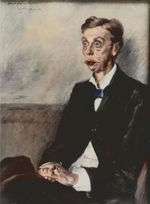Eduard von Keyserling

Count Eduard von Keyserling (May 14, 1855 – September 28, 1918) was a Baltic German fiction writer and dramatist and an exponent of literary Impressionism.
Biography
Keyserling was born at Schloss Tels-Paddern (now in Aizpute Municipality), Courland Governorate, then part of the Russian Empire, now Kalvene parish, Liepaja District, Latvia. He belonged to the Baltic German family of Keyserlingk and was a nephew of the geologist Alexander Keyserling. He died in Munich, Bavaria.
Keyserling's early novels Fräulein Rosa Herz. Eine Kleinstadtliebe (1887) and Die dritte Stiege (1892) were influenced by Naturalism. The later novels are more finely nuanced and less interested in assembling details. He is always interested in the interplay of light and natural objects. His novels and novellas are usually set in the German Baltic provinces, both in the noble houses and gardens and also in the fir forests and the outdoors generally. Most of his novels are suffused with a certain melancholy. They are peopled by minor aristocrats. Sometimes there are contrasting figures from a less exalted class; often this is a "child of nature," a person uncorrupted by civilization. Frequently there is a clash of generations. His novellas and novels, after 1902, place Keyserling at the forefront of German literary Impressionism. His essays on general and cultural questions, like his theater plays, are forgotten.
Keyserling enjoyed a literary reputation both in Germany and in the United States. His novels, translated into English in the late 1920s, were reviewed by literary critics, particularly in newspapers of record. His works were edited and anthologized for use in language pedagogy, perhaps as much for their accessible style as for their appealing story lines. His language is unusually chaste and concise. Sentences are never very long or complex.
A subtle and elegant stylist, Keyserling's narrative is unforgettable for its evocative ambience and "feel." His most emblematic work is perhaps Fürstinnen (Princesses), only superficially related to the typical German 19th century Schlossroman (the novel set in a castle or manor house). Somehow midway between Ivan Turgenev and Franz Kafka, there is a certain pessimistic kinship between Keyserling and Anton Chekhov.
Works
- Fräulein Rosa Herz- Eine Kleinstadtliebe (1887)
- Die dritte Stiege (1892)
- Die schwarze Flasche (1902)
- Beate und Mareille. Eine Schloßgeschichte (1903)
- Schwüle Tage (1904)
- Seine Liebeserfahrung (1906)
- Dumala (1908)
- Bunte Herzen (1909)
- Wellen (1911)
- Abendliche Häuser (1914)
- Im stillen Winkel (1914)
- Nicky (1914)
- Am Südhang (1914/16)
- Fürstinnen (1917)
- Feierstagskinder (1918)
- Gesammelte Erzählungen, ed. E. Heilborn, 4 Bde., Frankfurt a.M.1971–1973
Works Translated into English
- Gay Hearts: 1909. (=Bunte Herzen). Translated by Bayard Quincy Morgan. German Classics of the 19th and 20th Centuries, v. 19. New York: The German Publication Society, 1914.
- Twilight. (=Abendliche Häuser, Harmonie, and Kersta.) Translated respectively by James Ashton, Amy Wesselhoeft Von Erdberg, and A. W. Von Erdberg and E. Drew Arundel. New York: Macaulay, 1927.
- The Curse of the Tarniffs. (=Beate und Mareile). Translated by Arthur Jacob Ashton. New York: Macaulay, 1928.
- Tides. (=Wellen) Translated by Arthur Jacob Ashton. New York: Macaulay, 1929.
- The Man of God. (=Dumala) New York: Macaulay, 1930.
- "Princesses" (=Fürstinnen). Translated by John B. Rutledge.
https://cdr.lib.unc.edu/record/uuid:c8ac8d45-942e-4193-a2ca-88cbe9e92a83
- "Holiday Children" (=Feiertagskinder). Translated by John B. Rutledge.
https://cdr.lib.unc.edu/record/uuid:eaa8d49c-4c6b-4ec5-8b6d-103b3cc8c4f8
- "Number 2, Margaretenstrasse" (="Die Dritte Stiege"). Translated by John B. Rutledge.
https://cdr.lib.unc.edu/record/uuid:6e569a34-7c6b-4409-af17-7806eb41a171
- "In a Quiet Corner" (="Im stillen Winkel") Translated by John B. Rutledge.
forthcoming
Notes
Regarding personal names: Graf was a title before 1919, but now is regarded as part of the surname. It is translated as Count. Before the August 1919 abolition of nobility as a legal class, titles preceded the full name when given (Graf Helmuth James von Moltke). Since 1919, these titles, along with any nobiliary prefix (von, zu, etc.), can be used, but are regarded as a dependent part of the surname, and thus come after any given names (Helmuth James Graf von Moltke). Titles and all dependent parts of surnames are ignored in alphabetical sorting. The feminine form is Gräfin.
Further reading
- Richard A. Koc, The German Gesellschaftsroman at the Turn of the Century. A Comparison of the Works of Theodor Fontane and Eduard von Keyserling; (= EHSchr 1, 542); Bern 1982
- Richard A. Weber, Color and light in the writings of Eduard von Keyserling; (= Studies in modern German literature 39); New York 1990
External links
- Works by or about Eduard von Keyserling at Internet Archive
- Works by Eduard von Keyserling at LibriVox (public domain audiobooks)
